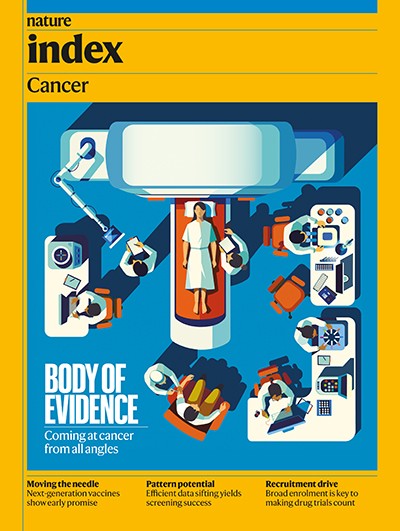Among the many most prolific younger researchers for cancer-related output within the Nature Index, these rising stars are bringing recent views to challenges in drug growth. From spiky nanoparticles that keep on with cells, to medicine that react when uncovered to X-rays to spice up the results of radiotherapy, these approaches may develop into highly effective new weapons within the arsenal used to struggle most cancers.
NAMHEE KIM: Mannequin maker

Illustration: Janelle Barone
Namhee Kim doesn’t wish to kill tumour cells — she needs to reprogram them to a standard, benign state. If this course of, generally known as most cancers reversion, might be triggered successfully, it may cut back the necessity for debilitating therapies corresponding to chemotherapy and radiotherapy.
As a computational biologist at biotechnology start-up Biorevert in Daejeon, South Korea, Kim is trying to find molecular switches that may induce most cancers reversion. Key to this work is controlling a course of generally known as epithelial-to-mesenchymal transition (EMT), which happens throughout occasions corresponding to embryonic growth, wound therapeutic and most cancers development. Cells swap from an epithelial state, by which they’re tightly packed and stationary, to being extra cell in a mesenchymal state. In most cancers, this helps malignant cells to unfold extra simply all through the physique.
Kim is growing algorithms from massive knowledge units to simulate how completely different elements inside a organic system may work together and performance as an entire, to establish the molecular switches. “It’s a really highly effective solution to analysis most cancers and could be very fascinating to me,” she says.
Nature Index 2025 Most cancers
The work builds on earlier analysis by Kim and colleagues on the Korea Superior Institute of Science and Expertise (KAIST) in Daejeon. They developed a mathematical mannequin for EMT and ran it via a pc simulation to see how it will play out in lung most cancers. The analysis revealed three molecular targets that would doubtlessly swap lung-cancer cells again to a benign state1. They then adopted this up with cell experiments to substantiate their findings.
In a separate research2, printed final 12 months, Kim and the group at KAIST investigated methods to control ‘grasp regulators’ — proteins that management the expression of huge teams of genes and so can direct sure organic processes and pathways inside cells. In stem cells, for instance, grasp regulators can dictate whether or not a cell will develop into a muscle cell, a neuron or one other kind of cell by binding to particular DNA sequences and switching sure genes on or off.
Kim and her colleagues examined their methodology by utilizing grasp regulators to alter mouse cells into several types of cells. Then, they used a most cancers community mannequin to point out how sure therapeutics might be used to control grasp regulators in most cancers cells to transform them from a malignant to a non-metastasizing state. As soon as the grasp regulator is recognized, a number of medicine — or mixtures of medicine — might be chosen for potential use in most cancers therapies, says Kim, who joined Biorevert final 12 months to proceed to her work.
Kim says she enjoys working in business as a result of it permits her to “shut the hole” between speculation and actuality. She expects synthetic intelligence (AI) to rework her subject, aiding in duties corresponding to knowledge evaluation and techniques modelling, however says the outcomes can usually be tough to interpret. “We researchers nonetheless must combine our techniques biology background and analytical abilities with AI to enhance its interpretations of advanced most cancers techniques.” — Sandy Ong
ZIWAN XU: Most cancers sensitizers

Illustration: Janelle Barone
Ziwan Xu made her mark by developing with new supplies for radiosensitizers — compounds used alongside radiotherapy to reinforce its effectiveness in opposition to most cancers. Radiosensitizers might be made out of many alternative supplies, relying on the particular operate that researchers need them to carry out. Cisplatin, for instance, used within the therapy of a number of sorts of cancers together with cervical, lung and ovarian, is made out of platinum. NBTXR3, a radiosensitizer composed of hafnium oxide, helps to deal with smooth tissue sarcomas — cancers that originate in smooth tissues corresponding to muscle mass, tendons, fats, nerves and blood vessels.
As a PhD pupil on the College of Chicago in Illinois, Xu developed a radiosensitizer that includes thorium, a naturally occurring heavy metallic. When thorium is uncovered to sure sorts of radiation, corresponding to that utilized in radiation remedy, it produces extra radiation and unstable molecules referred to as reactive oxygen species (ROS), each of which may injury most cancers cells. The radiosensitizer additionally incorporates photosensitizing molecules referred to as ligands, which produce additional ROS when uncovered to radiation. Collectively these components increase the injury dealt to most cancers cells by radiation remedy with out requiring the next dose.
To design the radiosensitizer compound, Xu used a way generally known as Monte Carlo simulation, which is used to mannequin the chance of assorted outcomes. “The Monte Carlo simulation work was really a undertaking I initiated in the course of the pandemic, after we had no entry to the lab,” says Xu. She and her colleagues have been later in a position to take a look at the effectiveness of the design in experiments. They injected the thorium-based materials into mice present process radiotherapy and located that it helped to suppress the expansion of colon most cancers and pancreatic tumours, in contrast with a management group that was additionally uncovered to radiation3.
In 2023, Xu took on a task on the pharmaceutical firm Merck, based mostly in Rahway, New Jersey, to check one other problem in most cancers drug-making: designing injectables that may stay energetic within the physique for lengthy durations. These medicine should be fabricated from crystals which might be massive sufficient that they dissolve slowly within the physique, however not so massive that they clog the needle when administered, she says. A affected person’s immune response to the injectable can change over time, too, which may result in issues.
Xu says she feels fortunate to get recommendation from consultants in lots of fields at Merck. “Somebody can provide me strategies on the analytical strategies I exploit, and somebody can brainstorm with me on completely different instrumentations and completely different simulation strategies,” she says. “You possibly can all the time get help. Working on the universities, I had collaborators, nevertheless it was principally restricted to our lab.”
Having moved to the US from China in 2017 as an undergraduate pupil, Xu says transferring from academia to business felt like a much bigger change than transferring nations. She compares the broad scope of educational work to the extra targeted work she’s been doing at Merck. In academia, “we begin from a molecular design and go all the way in which to preclinical research”, she says, whereas at Merck, she appreciates with the ability to concentrate on only one a part of the scientific course of. — Felicity Nelson
JIE TANG: Vaccine nanoparticles

Illustration: Janelle Barone
Together with her group at Monash College in Australia, Jie Tang is growing an reasonably priced vaccine for colorectal most cancers that may be swallowed as a capsule. It’s no small feat, she says, as a result of the digestive tract quickly degrades and clears something that’s swallowed, which doesn’t go away a lot time for an oral vaccine to assist practice the immune system. To beat this problem, Tang added a particular ingredient to the capsule: a spiky silica-based nanoparticle4 that sticks to the liner of the intestine, guaranteeing that it stays in place for about 12 hours — lengthy sufficient to ship the vaccine’s antigens. Tang was impressed by pollen grains and bristly seeds that keep on with clothes and fur, and that are just like the hair-like surfaces on viruses that assist them connect to cells. She first developed these nanoparticles in 2021 as a postdoctoral pupil on the College of Queensland in Australia, earlier than refining the design at Monash.
The spiky nanoparticles assist the vaccine’s antigens to penetrate immune cells and ‘educate’ T cells to acknowledge and assault most cancers cells which have related antigens. On the identical time, the nanoparticles disrupt the ion stability of immune cells referred to as dendritic cells, inflicting a few of them to die off. This carnage prompts different immune cells, corresponding to T cells and pure killer cells, to hurry to the location, additional boosting the physique’s immune response.
Silica nanoparticles have a wide selection of makes use of, from drug supply to biomedical imaging and electronics. Those used for drug supply primarily act as inert autos for medicines, says Tang. “Our spiky silica nanoparticles are engineered for immune activation,” she says. “They’re modified with floor chemistry that enhances vaccine response.” Tang provides that the nanoparticles stay secure inside the intestine fluid and might penetrate the protecting layers of the intestinal tract to achieve the underlying immune cells. Silica nanoparticles are low cost and straightforward to make, she says, so make a “good candidate for scalable vaccine expertise”.
These nanoparticles may additionally show helpful in agriculture, says Tang. They are often stuffed stuffed with antimicrobials, such because the protein lysozyme, and fed to livestock — a characteristic that US animal diet firm Ridley is at the moment exploring in collaboration with the College of Queensland.
Earlier than her work at Monash, Tang was concerned in creating a special spiky silica-based nanoparticle — this one characterised by its hole inside5. Developed as a part of a undertaking led by supplies scientist Chengzhong Yu on the College of Queensland, the nanoparticle’s cavity might be full of massive biomolecules, corresponding to DNA and RNA, which were engineered to affect mobile behaviour and gene expression at focused places.
The nanoparticle has been patented by the college and has attracted sturdy curiosity from business as a result of it may be custom-made, says Tang. In 2018, N4 Pharma and AstraZeneca used the expertise to develop Nuvec, a vaccine-delivery system for treating most cancers and different ailments, which is in preclinical testing.
